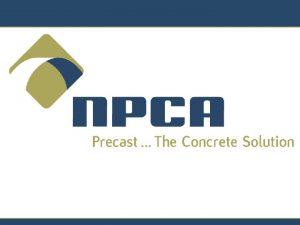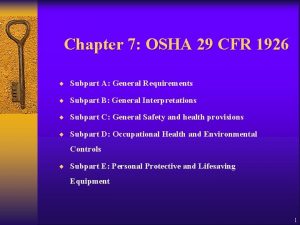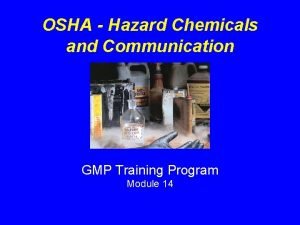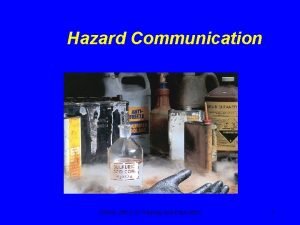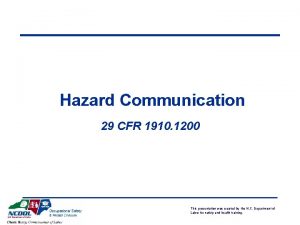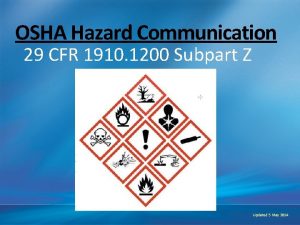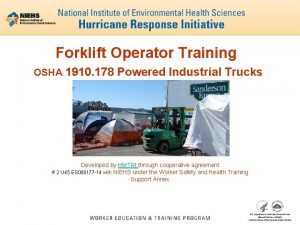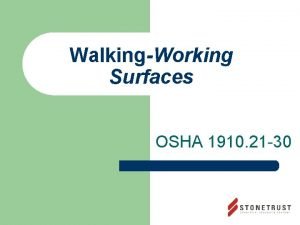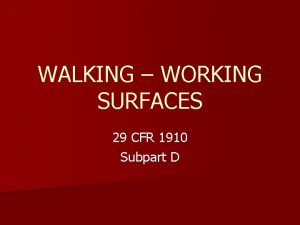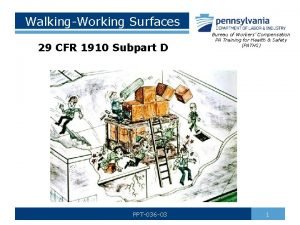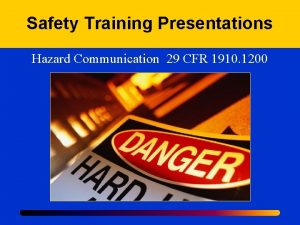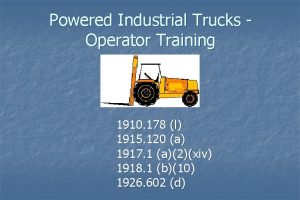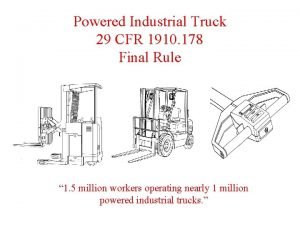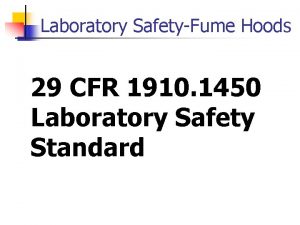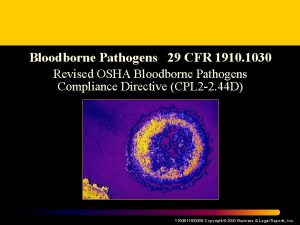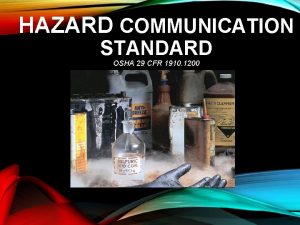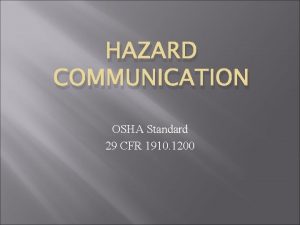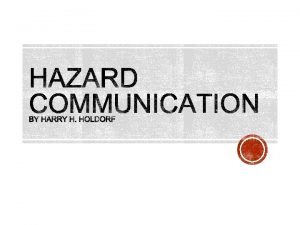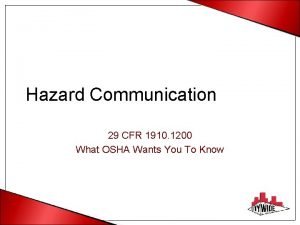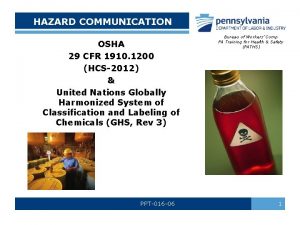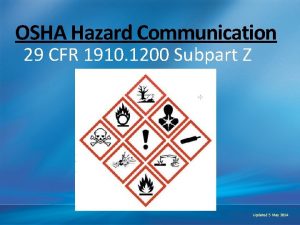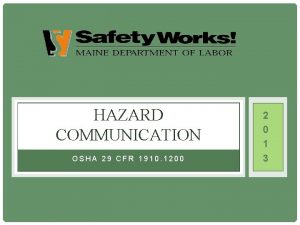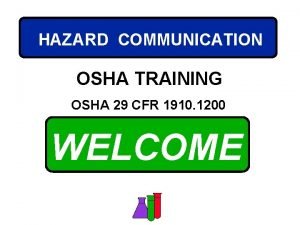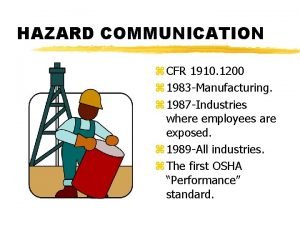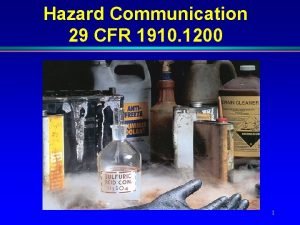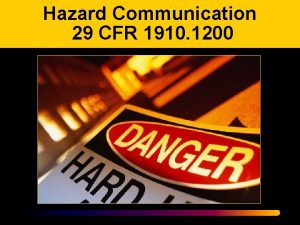OSHA HAZARD COMMUNICATION STANDARD 29 CFR 1910 1200
















- Slides: 16

OSHA HAZARD COMMUNICATION STANDARD (29 CFR 1910. 1200) (UNIT-III)

OSHA HCS • OSHA requires the development of a written hazard communication plan. • The plan must address container labelling, SDS availability, and training requirements. • The plan must direct the actions taken to communicate appropriate hazard information to all affected or exposed individuals. • Employers must identify the person responsible for each plan element. • Organizations must make the plan available on all shifts.

Globally Harmonized System • GHS -international approach to hazard communication which provides criteria for classifying chemical hazards and standardizing labels and SDS. • The development of GHS required a multiyear endeavour by hazard communication experts from different countries, international organizations, and stakeholder groups. • OSHA recently modified the HCS to adopt the GHS approach. Since 1983, OSHA requires employers to communicate hazardous materials information to employees. • The original performance-oriented standard allowed chemical manufacturers and importers to convey information on labels and SDS in a variety of formats. • GHS requires a more standardized approach to classifying the hazards, standardized label assigned by hazard category and conveying information. • The GHS requires providing detailed criteria for determining what hazardous effects a chemical poses. This will enhance both employer and worker comprehension of the hazards, resulting in safer use and handling. • The harmonized format of the SDS will enable employers, workers, health professionals, and emergency responders to access the information more efficiently and effectively. • OSHA will require training on new label requirements and SDS format by December 2013. OSHA will require complete compliance in 2015.

Major HCS Changes • Specific criteria for the classification of health & physical hazard and the classification of mixtures will help to ensure that evaluations of hazardous effects remain consistent across manufacturers. This will result in more accurate labels and SDS. • Chemical manufacturers and importers must provide a label that includes a harmonized signal word, pictogram, and hazard statement for each hazard class and category. Precautionary statements must also be provided. Finally, the SDS will contain a specified 16 -section format. • The OSHA standard related to basic framework, scope, and exemptions remain unchanged. • The original standard did not include categories for most of the health hazards covered. • The revised hazard standard – requires retraining of all workers within 2 years of the publication of the final rule. – The term hazard determination changed to hazard classification and material safety data sheet changed to safety data sheet. – Evaluation of chemical hazards must use available scientific evidence. – Contains specific criteria for each health and physical hazard with instructions about hazard evaluations and determinations. – Establishes hazard classes and hazard categories. The standard divides the classes into categories that reflect relative severity of the effect.

New Labelling Requirements

New Labelling Requirements • • Pictogram: uses a symbol plus other graphic elements to convey specific information about the hazards of a chemical. Each pictogram consists of a different symbol on a white background within a red square diamond frame. The system requires the use of nine pictograms. However, OSHA requires the use of only eight pictograms under the revised standard. Signal words: include danger and warning, to indicate the relative level of the severity of hazard. Use danger for severe hazard and warning for less severe hazards. Hazard statement: a statement assigned to a hazard class and category that describes the nature of the hazards of a chemical. It also includes the degree of hazard. Precautionary statement: describes recommended measures to minimize or prevent adverse effects that could result from exposure to a hazardous chemical. It also applies to the improper storage or handling of a hazardous chemical. The revised standard requires the printing of all red borders on the label with a symbol printed inside. Chemical manufacturers, importers, distributors, or employers who become aware of any significant information regarding the hazards of a chemical must revise labels within 6 months of becoming aware of the new information. Employers can label workplace containers with the same label affixed to the shipped containers. Employers can also use label alternatives, including those described in NFPA 704, Hazard Rating and the Hazardous Material Information System. However, the information supplied on alternative labels must meet the requirements of the revised standard with no conflicting hazard warnings or pictograms.


Safety Data Sheet Changes • The original standard requires specific information but did not specify a format for presentation or order of information. • The revised standard requires presenting the information on the SDS using consistent headings in a specified sequence. The SDS format remains the same as the ANSI standard format. Required SDS Information • Section 1. Identification • Section 2. Hazard(s) identification • Section 3. Composition/information on ingredients • Section 4. First-aid measures • Section 5. Fire-fighting measures • Section 6. Accidental release measures • Section 7. Handling and storage • Section 8. Exposure controls/personal protection • Section 9. Physical and chemical properties • Section 10. Stability and reactivity • Section 11. Toxicological information • Section 12. Ecological information • Section 13. Disposal considerations • Section 14. Transport information • Section 15. Regulatory information • Section 16. Other information, including date of preparation or last revision Note: OSHA does not mandate inclusion of Sections 12– 15 in the SDS.

Continued. . . • • OSHA plans to retain the requirement to include the ACGIH TLVs on the SDS. This will provide useful information to help them assess the hazards presented by their workplaces. OSHA will also require the inclusion of Permissible Exposure Limit (PELs) and any other exposure limits used or recommended by the chemical manufacturer, importer, or employer while preparing the SDS. The revised standard provides classifiers with the option of relying on the classification listings of IARC and NTP to make classification decisions regarding carcinogenicity (formation of cancer) rather than applying the criteria themselves. OSHA also included a non-mandatory Appendix F in the revised standard to provide guidance on hazard classification for carcinogenicity. – Part A of Appendix F includes background guidance provided by GHS based on the “Preamble” of the IARC “Monographs on the Evaluation of Carcinogenic Risks to Humans. ” – Part B provides IARC classification information. – Part C provides background guidance from the National NTP “Report on Carcinogens. ” • GHS Does Not Affect the Aspects of Pesticide Regulation Managing and Communicating Changes to the HCS • GHS as a living document with expectations of relevant updates on a 2 -year cycle. • OSHA anticipates future updates of the HCS to address the minor terminology changes, final rule text clarification, and additional rule-making efforts to address major changes.

Employee Training • The OSHA HCS requires employers to provide employees information and training on hazardous chemicals used in their work areas. • Employers must conduct training at the time of their initial assignment and upon the introduction of a new hazardous substance. • Training must address the methods and observations used to detect the presence or release of the chemical. It must also address physical and health hazards, protective measures, labeling, and an explanation of the SDS. • Employers must inform employees of the hazards of non-routine tasks and the hazards associated with chemicals in unlabeled pipes. HAZCOM-Mandated Training Topics • Existence and requirements of the OSHA HCS • Components of the local hazard communication plan • Work areas and operations using hazardous materials • Location of the written hazard evaluation procedures and hazard communication plan • Location of the hazardous materials listing • Location and accessibility of the SDS file

DOT Hazardous Material Regulations (UNIT-III)

Hazardous materials regulations (HMR) • The secretary of the DOT – receives the authority to regulate the transportation of hazardous materials from the Hazardous Materials Transportation Act, as amended and codified in 49 USC 5101 et seq. – issue regulations to implement the requirements of 49 USC. • The Pipeline and Hazardous Materials Safety Administration (PHMSA) holds the responsibility to write the HMR, contained in 49 CFR Parts 100– 180. • HMR changed significantly in recent years. • The applicability of the hazardous materials regulations now extends to all intrastate shipments of hazardous materials by highway. • Special agents of the DOT cannot be denied reasonable access to those areas that fall within the official scope of their duties. • The secretary delegates authority to the FMCSA (The Federal Motor Carrier Safety Administration), Federal Railway Administration, PHMSA, and the USCG (United States Coast Guard). • The Hazardous Materials Table (located in 49 CFR 172. 101) provides the initial step toward how to ship a product which has – – Proper shipping name (PSN), hazard class, UN identification numbers, labels and packaging types necessary.

Proper shipping name (PSN) • Locate the PSN from the alphabetically arranged Hazardous Materials Table. DOT Hazard Classes • Class 1: Explosive (1. 1– 1. 6) • Class 2: Gases (2. 1 Flammable, 2. 2 Non Flammable, 2. 3 Poisons) • Class 3: Flammable/Combustible Liquids • Class 4: Solids (4. 1 Flammable, 4. 2 Spontaneously Combustible, 4. 3 Dangerous When Wet) • Class 5: Oxidizing Agents (5. 1 Oxidizers, 5. 2 Organic Peroxide) • Class 6: Poisons (6. 1 Poisons, 6. 1 Keep Away from Food, 6. 2 Infectious Material) • Class 7: Radioactive (Radioactive I, Radioactive III) • Class 8: Corrosive • Class 9: Miscellaneous

• Identify the contents of a shipment using shipping papers, markings, labeling, and placard information. • A marking can include handwritten or a preprinted self -adhesive label containing required information – PSN, the United Nations/North American (UN/NA) identification number, and the consignees or consignor’s name and address. • Labelling using a 4ʺ × 4ʺ square-on-point label helps visibly identify a hazardous materials package. • When using two labels, the less hazardous of the two is a secondary hazard. • Use Special Precautions Labels such as Empty or Cargo Aircraft Only if required. • OSHA standard 29 CFR 1910. 1201 requires original DOT labels to remain on vehicles, tanks, and containers until removal or transfer of labeled substances.

Placards • Depending on the type and quantity of a shipment, placarding completes the identification process. • Larger than labels, placards measure 10¾ʺ × 10¾ʺ but retain a similar square-on-point design. • Placards deal with a specific hazard class of materials. • DOT requires strict specifications for color, size and wording, and placement on a shipping vehicle (49 CFR 172. 500. 172. 560). • Two tables help determine the requirement for placards (49 CFR 172. 504). • DOT requires placards for secondary hazards. Secondary hazards must follow the requirements contained in 49 CFR 172. 519.

Containers • Determining the applicable container for shipping a hazardous material depends on the UN identification code on the drum. • To find information on a chemical, refer to the Hazardous Materials Table, SDS, Merck Index, CRC Handbook of Chemistry and Physics, or contact the manufacturer of the chemical. Hazardous Materials Training • Specific requirement located in 49 CFR 172. 704. • Air 49 CFR 175. 20, Vessel 49 CFR 176. 13, and Highway 49 CFR 177. 800– 177. 816. • Use a systematic approach, consistent in approach, testing, and documentation. • Ensure employees understand the regulations and can perform assigned functions. • DOT 49, Hazardous Materials Table found in CFR 172. 101 designates hazardous materials. • List encompasses a wide range of chemicals and combustible/flammable liquids.
 Osha hazard communication standard 29 cfr 1910
Osha hazard communication standard 29 cfr 1910 Hazard communication 29 cfr 1910
Hazard communication 29 cfr 1910 Osha 29 cfr 1910 1200
Osha 29 cfr 1910 1200 Osha hazard and ghs training regulation cfr 1910
Osha hazard and ghs training regulation cfr 1910 Osha cfr 1910 is the standard for______.
Osha cfr 1910 is the standard for______. Osha 1910 psm standard
Osha 1910 psm standard 29 cfr 1910 section 1200
29 cfr 1910 section 1200 Osha 1910 forklift
Osha 1910 forklift 29 cfr 1910 osha 178
29 cfr 1910 osha 178 Osha 1910 housekeeping
Osha 1910 housekeeping Osha fixed ladder requirements 1910
Osha fixed ladder requirements 1910 Osha 29 cfr 1910 subpart d
Osha 29 cfr 1910 subpart d Hazard communication safety training quiz answers
Hazard communication safety training quiz answers 29 cfr 1910 osha 178
29 cfr 1910 osha 178 29 cfr 1910 osha 178
29 cfr 1910 osha 178 29 cfr 1910 osha 178
29 cfr 1910 osha 178 Bloodborne pathogens standard 29 cfr 1910
Bloodborne pathogens standard 29 cfr 1910

